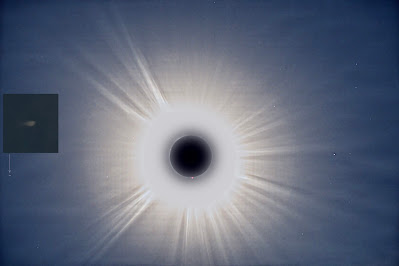 |
| Total Solar Eclipse - April 8, 2024 -Westport, New York |
On April 8, 2024, a celestial event of spectacular proportions graced the skies: a total solar eclipse. For those of us in Westport, New York, the day held an air of anticipation, excitement, and a touch of the ethereal, as we prepared to witness day turn into night under the eclipse's path of totality.
Westport, nestled along the scenic shores of Lake Champlain, became a buzzing hub for eclipse chasers, all eager for a front-row seat to nature's grand spectacle.
Westport Golf, known for its lush fairways and stunning views, offered a picturesque setting for eclipse viewing. The expansive greens provided a clear, unobstructed view of the sky, making it an ideal location for observation. As the eclipse approached, the course was transformed into a field of curiosity and excitement, dotted with telescopes, cameras, and spectators donning their eclipse glasses.
The darkness of totality was profound yet fleeting, lasting approximately 2 minutes and 40 seconds. During this brief interlude, the surroundings were bathed in a twilight glow, a surreal moment that felt out of place yet deeply moving. The visibility of stars and planets in the midday sky, particularly Venus’s bright appearance, added a stellar touch to the spectacle.
My set up for Totality: Canon Ra, Canon EF200mm f/2.8L II USM Lens + Canon 2x III Extender = 400mm, F/8, ISO 200. The precision with which these images were captured was further ensured by the use of an iOptron SkyTracker mount, which tracked the sun's movement across the sky, eliminating potential blurring from the Earth's rotation. Moreover, the integration of the SET'n'C (Solar Eclipse Timer and Controller) provided an automated approach to timing and exposure adjustments, critical for dealing with the rapidly changing light conditions during the eclipse.
Beginning of totality, diamond ring - single photo with fast shutter speed of 1/1000 sec. Amidst the rarefied beauty of celestial events, the Diamond Ring effect stands out as a fleeting, yet unforgettable moment. It heralds the beginning and conclusion of totality during a solar eclipse, a spectacle where the moon and the sun perform a celestial dance across the sky.
 |
| Diamond Ring Contact 2 of Total Solar Eclipse April 8 2024 as seen from Westport, New York |
Solar Corona - single photo with fast shutter speed of 1/16 sec. The image stands as a stunning testament to the celestial dance between light and darkness, showcasing the corona's delicate filaments and radiant glow against the backdrop of space.
 |
| Solar Corona of Total Solar Eclipse April 8, 2024 - Westport, New York |
Solar Flares - single photo with fast shutter speed of 1/1000 sec. The conjunction of the eclipse with these solar eruptions offers a glimpse into the sun's dynamic power, highlighting the beauty and intensity of our star's active nature.
 |
| Solar Flares - Total Solar Eclipse April 8, 2024 - Westport New York |
End of totality, diamond ring - single photo with fast shutter speed of 1/1000 sec.
 |
| Diamond Ring Contact 3 (Post-totality) of Total Solar Eclipse April 8, 2024 as seen from Westport, New York |
First photo in the post - average mean of 40 photos with different exposure time from 1/1000 to 1/2 seconds.
As the eclipse passed and daylight returned, the sense of communal experience lingered. Gathered on the golf course, we shared in the wonder and ephemeral beauty of the cosmos, a reminder of the universe’s grandeur and our place within it. The total solar eclipse of April 8, 2024, observed from the Westport Golf in New York, was not just a celestial event; it was a profound communal experience, an opportunity to connect with the cosmos and with each other in a moment of fleeting darkness and enduring wonder.







































%20Sign%20at%20Night.jpg)










